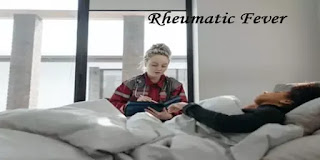Definition
Post-streptococcal fever, characterized by acute polyarthritis, and a high incidence of carditis. Streptococci belong to group A Beta-hemolytic streptococci. Gradually it appears 2-3 weeks after a sore throat.
Cause / Etiology
- Age: Usually in the lower group (5-15 years)
- Gender: Women are often seen
- Season & Weather: Especially in winter and in warmer climates
- Heredity: It may run in families
- Social environment: Affects poor category living in unhealthy conditions
- High respiratory infections: Often preceded by more respiratory diseases, usually tonsillitis, pharyngitis, etc.
Diseases
There are two types of response - exudative and exaggerated
Exudative regeneration includes edema, congestion, and leucocyte infiltration of collagens.
Exaggerated: A growing response to Aschoff nodules forming necrotic masses between fibrinoid mutations, in which there are fewer histiocytes, larger cells (Aschoff cells), and lymphocytic infiltration. The most important aspect of rheumatic pathology is pancarditis i.e. endocarditis, myocarditis, and pericarditis.
Symptoms
- The onset is usually sudden, which can be tricky as well.
- Fever: Usually low, perhaps high but persistent, not associated with cold or stiffness
- Joint Inflammation: There is arthritis that affects especially the big joints - first knee, ankles, wrists, elbows, shoulders, and hips. Joints become inflamed due to periarticular effusion
- Participatory involvement is more significant for adults than children
- Sweating: Sweating is usually moderate and sometimes irritating and irritating
- Symptoms of constitutionalism: Anorexia, constipation, weakness, etc.
Signs
- The patient is usually a 5- to a 51-year-old girl
- The temperature is high, the face is swollen and the tongue is dry
- Pulse: Without temperature measurement during sleep
- Tons can be enlarged or infected
- The child takes a stand that does not allow the members to be injured
Skin changes
Rheumatic nodules: These are small, non-tender nodules found above the bone marrow or around the affected joints. They are naturally a combination of Aschoff nodules.
Erythema nodosum: Tender nodules are present mainly on the tibia.
Erythema marginatum: These are the red spots seen above the stem, their edges high and irregular. Some coalesce with large patches.
The heart changes (Expert Homeopathy: Dr. Anutosh Chakraborty)
- Apex beat may shift
- The heart rate rises
- The first heartbeat is emphasized by the softness
- Soft systolic sigh (Carey coomb sigh) due to mitral valvulitis
- Symptoms of congestive heart failure may appear
- Cardiomyopathy
- Sometimes pericardial infarction can be felt due to concomitant pericarditis
Jone's method of diagnosing rheumatoid arthritis
Major
Carditis
Rheumatoid arthritis
Pumps under the skin
Chorea
Erythema marginatum
Minor
Fever
Arthralgia
Past rheumatic fever / rheumatic heart disease
Lab
Effective phase response, leucocytosis, ESR, CRP
Limited PR time on ECG.
It's important
Evidence of streptococcal infection exhibited by ASO
Good throat culture
Recent red fever
The presence of 2 major or 1 major and 2 minor procedures is diagnostic.
Complication
- Heart failure
- Rheumatic heart disease
- Arrhythmias
- Pericarditis
- Pneumonitis
Treatment
- Take a Rest
- Local joint care involved: wool bandage with flexible metal
- Food: milk, bread, etc.,. nutritious and easily digested food during febrile.
Homeopathic remedies (Expert Homeopathy: Dr. Anutosh Chakraborty)
Aconite: Fever characterized by instability and mental anguish. Pain in the joints with noted thirst.
Bryonia: A lot of pain in the joints with minimal movement. Stronger, better sleep on the sore side.
Rham California: Rheumatic arthritis, swollen joints, pain with a tendency to metastasis, profuse sweating. Rheumatic heart.


Post a Comment